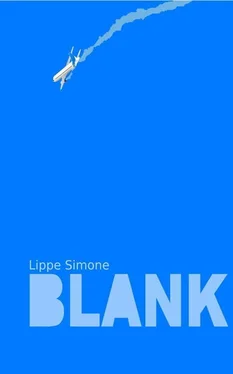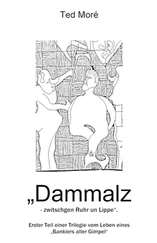Or he could tear this laboratory apart in the vanishingly slim hope that some trace of the vaccine or indication where it could be acquired was hidden somewhere among the unreasonably scant paperwork and beakers and bottles.
Finally he could try to make his way in the world. He could return to the original plan and escape the psychiatric ward and chance finding help somewhere in a Los Angeles that was now seething with primitive factional violence. Or he could jump off the roof.
It had been roughly 12 hours since his first memory in the mental ward, a very rough 12 hours. Whatever torments this dystopian world had visited upon him in that time — and it had somewhat overachieved in the area of dystopian torments — and whatever it yet had in store he felt reasonably certain that there was absolutely nothing now that would surprise him. And he was wrong about that. As he sought inspiration out his laboratory window his eye was drawn by three giraffes, two adults and a baby giraffe, travelling north at a leisurely gallop on the otherwise abandoned Pacific Coast Highway. They seemed to have some idea where they were going and from this the scientist deduced that animals were somehow or to some degree immune to the effects of the sun’s radioactive outbursts. Anyway there were giraffes on the freeway.
The former Ray scanned back along the freeway for other surprises and found one. At that distance it was difficult to say with any certainty that what he saw was actually a tank, but what looked very much and behaved even more like a tank was driving over the cars blocking Venice Boulevard, heading toward the ocean.
Casting his mind back, he found that he couldn’t. He opened his eyes to find that he was looking directly into the sun, which profited from the opportunity to punch him squarely in the back of the brain, so he closed them again. He had a headache. He was a headache. His head ached with a blunt, expansive, exhaustive, prize-fighting and prize-winning ache. He had a headache bigger than his actual head.
Sunlight pressed on his eyelids like deep-sea fishing weights but when he raised an arm to cover them he found that the headache was a distraction, a very potent distraction, from a general malaise throughout his body but with particular emphasis on the joints, which felt as though they’d been packed in ice, ready for shipping. In his stomach something was growing slowly but determinedly larger and it was now ready to leave the nest. His lips and tongue had been, apparently, upholstered.
With no clear memory of a similar sensation he diagnosed with absolute certainty the symptoms of a monstrous hangover. He tried to lay motionless with a very fuzzy plan to remain that way until the sun went down, however long that took, but his body insisted on rocking in gentle, consistent, rhythmic and nauseating waves, as though he were on a boat in the ocean. He could even almost hear the water slapping against the hull and seagulls screeching like poorly aligned disc brakes somewhere overhead.
With a heroic force of will he isolated the sound of the gulls as not a symptom of his condition but as a real external stimulus. It was actually seagulls and he really could hear waves and he was, in fact, on a boat. The rest was still a hangover.
He yawed into a sitting position before risking opening his eyes again but there was little improvement. He was on the top deck of a wide fiberglass yacht of a pure white that faithfully reproduced the sun’s assault on his squinting eyes so that everything glowed like a dream sequence in an Italian art film. He was even dressed from shoulders to feet in pristine white sailor’s cottons and was, until further notice, indistinguishable from the deck. And he had reason to doubt these were his clothes. They had nothing at all in the pockets, which could have borne very little in any case, and they fit his boxer’s frame like a sausage casing.
He stood, finally, with the stability of a Great Dane on a trampoline, and took in the horizon, which required the further effort of turning in a complete circle because the horizon was everywhere. In all directions for as far as he could see there was the ocean’s edge, simmering in the close, cloying heat of the sun so that the edges blurred into the sky. He was alone on a yacht in the middle of the ocean and he hadn’t a fuzzy, achey, throbbing idea how he got there. But was he really alone? Probably not. Probably there was someone else on the boat who knew who he was and how much he’d had to drink, if that was even measurable.
The upper deck where he’d been sleeping was empty but for countless Champagne bottles and from what he could see of the main deck it was deserted too. He eased down the steps to the main deck at the bow and walked with his knees cautiously bent to absorb as much of the motion of the waves as possible. It was a big boat. He had a long walk ahead of him to the aft where, he reasoned, he would find the cabin and the bridge and, of greater importance, some shade.
And his instincts had been exactly right. After a long and not notably scenic tour of the boat’s gleaming white port side, interrupted by a refreshing pause to release some of the overflow of the self-reproducing swill in his stomach, he arrived at the stern with a diving platform and steps up to the bridge and wide and curtained French patio doors leading to the cabin.
The cabin was, if anything, hotter than it was outside. There was no circulating air and the thick atmosphere testified to several hours in this state. This was clearly where most of the celebrating had been done. There were yet more bottles, this time of hard liquor and wine and the sweet liqueurs of unnatural colors which contribute so efficiently to the well-rounded hangover. There was evidence of food, as well, and the smoking of cigars and a total dereliction of duty on the part of the cleaning staff. And finally at a banquette table fixed to the starboard wall was a man and a woman in their late sixties eating jam with their fingers.
They didn’t look like the sort of couple who normally ate jam with their fingers. They looked like the sort of couple who normally told the staff of their yacht how they liked their steaks, although it was always rare because it always is with the very best cuts of meat. They were dressed as though they’d been to a wedding of someone they didn’t know very well. She wore pearls. He wore epaulettes. They both wore a look of total stupefaction. They looked at the intruder with fear and suspicion when he came in through the French doors and turned with their pots of jam toward the wall in a clear gesture that they were unwilling to share.
“Hi.” croaked the hangover, and vainly tried to clear his throat. “Do you know who I am?” Neither of his hosts looked at him, they just accelerated their consumption of jam.
“I’m guessing that’s a no.” he said. “It’s mutual. Do you know where we are? Where the crew is? Where land is? How about aspirin? Do you know where you keep the aspirin?” The couple finished their jam and licked their fingers and scanned the wreckage for more leftovers. Simultaneously zeroing in on a shrimp cocktail ring with a sauce that had grown a thick skin, they raced for it, retrieved it and took it back to their little lair.
“Okay, that’s a little strange. But fine. It’s not a pressing matter. I’ll just call you Marmalade and Apricot. You can call me, say, Clint. Clint Hardcastle. No, Clint Hardcliff. Yes, I like that. Clint Hardcliff.” Marmalade and Apricot made no objection and the formalities were complete.
Beyond the expansive salon was a galley door and the man who called himself, quite recently, Clint, left his new acquaintances to investigate the deeper recesses of a luxury yacht. The door led to a corridor of modern eclectic excess. The deck was polished oak and the walls brushed aluminum with glass wainscoting and mounted photographs of, presumably, celebrity visitors to the boat. Stateroom doors and stained-glass wall-lamps alternated down the hall and everything from the hand-polished floors and beveled glass moldings to the overly composed pictures of movie stars and mobsters was covered with a coating of congealed blood. What forensic examiners lyrically call the splatter pattern suggested a fast-paced sabre battle between unevenly matched opponents or the lively pursuit of a spirited amputee by mountain lions.
Читать дальше












